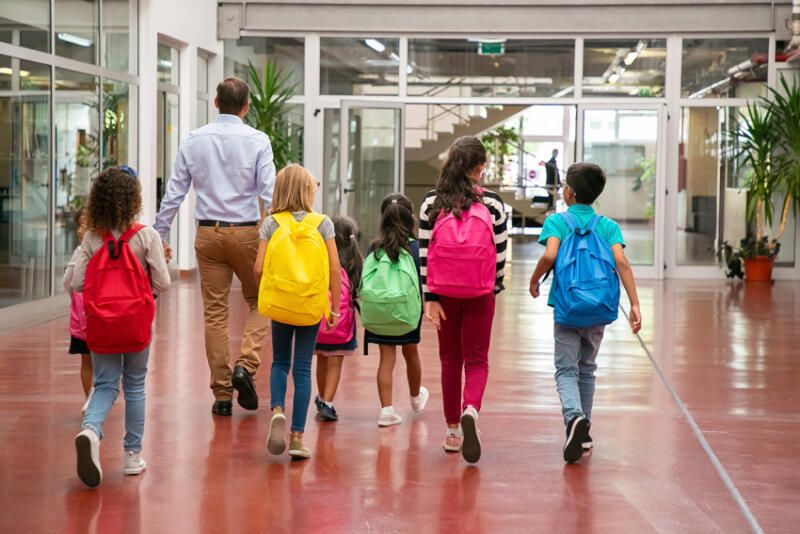Community Schools: The Answer to Catching Up on Learning Loss for Kids
The pandemic has deepened education divides for children. Amid two years of remote learning, millions of children have fallen behind expectations for reading and math levels. At a briefing held Mar. 18 by Ethnic Media Services, speakers – Louis Freedberg, past executive director of EdSource and veteran education journalist; Hayin Kimner, Managing Director for the Community Schools Learning Exchange, and a Senior Policy and Research Fellow for Policy Analysis for California Education; and Allison Socol, Assistant Director of P12 Policy, Ed Trust, Washington, DC – discussed strategies to bridge the learning gap.

Freedberg discussed reframing the narrative to what might inspire kids to return to in-person learning. He also discussed performance-based learning, connecting schoolwork with career pathways, and bringing art and music education back to school which has been missing for some time.
“Many students who were already struggling before the pandemic are now doing worse. There are proven strategies to engage students which are being done at various levels of different parts of the country. One of the most important goals is to get kids excited about learning, about being in school. For too long, the focus and the whole narrative in schools has been on testing and grades and that doesn’t work for most people and there’s been huge amount of research over many decades on extrinsic motivation, in other words, doing things for some external purpose, like a grade. This intrinsic motivation is doing things because you are internally motivated. You’re always going to have something that most kids will need, some kind of testing, or exam, but that shouldn’t be the main thing driving how we teach kids,” said Freedberg.
“Project-based learning has seen a huge amount of work being done. George Lucas, the producer-director of Star Wars, etc., who’s been really in the trenches on education started something called Edutopia (https://edutopia.org) and also the Lucas Foundation (https://lucasfoundation.org) have been taking an approach in which students explore real-world problems through individual and group projects.
“A teacher in San Jose, Calif., for third graders, had kids design and build a model for a house. The tiny house project allows the teacher to teach many parts of the school curriculum. They had to figure out the minimum squared footage, they had a structural engineer come into the class they made the blueprints, they had to figure out the difference between area, total area of the house and the perimeter. You got all the math. Then they had kids reading up about different approaches for building houses. You’ve got reading in there. Then they had the kids eventually had to present this their model to a client, so they were taught and okay posture and how to make the presentation and speak clearly,” said Freedberg.
“In another project, the chemistry teacher took the Flint, Michigan water crisis, and had the students trying to identify one of the key elements that the Flint local authority had missed. It was a chemistry problem of putting a certain chemical in the water to prevent the lead from leaching into the water.
“Other strategies that have really been impressive are link learning. Linking students, and this is more at the middle and high school level, to career pathways. It’s not just going in and giving a lecture to the students about career or providing internships, it’s a well thought out strategy, tying the career pathways to courses. Having career technical education courses providing internships and then providing support services in the schools like counseling and supplemental reading, these are all well thought out strategies.
“Another approach to motivate students is dual enrollment strategies, where you link high school, or even middle school and high school students to community colleges where they can take courses in both high school, or middle and high school, and combine college courses. Students who are really succeeding get a sense of pride that they are actually doing these college courses. It also gives them a taste of the college culture. It also allows them to get out of the normal routine,” said Freedberg.
“We have to bring other arts and music programs back into the schools this is not necessarily for every student, but this used to be a key part of the school curriculum and unfortunately, it’s been eviscerated across the country. We’re very fortunate in California, there’s a big push to get an initiative on the ballot this November to invest the billion dollars more into arts and education program in the schools. Sports programs, similarly, shouldn’t just be for the students who are really serious, it really should be available to more students and unfortunately those have also been cut back, but these are the kinds of things we need to be thinking about now and looking at who is doing it well because there are people who are doing this it’s just how do we extend that more broadly to more schools and more students,” concluded Freedberg.
Allison Sokol drew attention to schools which are succeeding in accelerating learning with some specific examples and what these schools share in common.
“What is unfinished learning?” began Sokol.
“In our terminology, unfinished learning is our way of talking about what others often call learning loss or learning gaps. We choose to use the phrase ‘unfinished learning’ for two big reasons, the first is that it’s a more asset frame that we hope signals that with resources and support, students can absolutely make progress, and the second reason that we use the phrase unfinished learning instead of learning loss is because we hope it shifts the focus away from blaming students and puts the responsibility on the systems,” said Sokol.
“At the beginning of the pandemic, in March of 2020, the Education Trust partnered with a research firm called MDRC because it became immediately apparent that the pandemic was going to have a huge impact on students and specifically students of color and students from low-income communities. We wanted to be able to answer the question how could we help these students and how can we accelerate their learning, given the impact of pandemic and school building closures, and the disproportionate health and financial impact of a pandemic on communities of color.
“We found that the strategies that are most effective for addressing students unfinished learning fit in three buckets. The first bucket is targeted intensive tutoring which sometimes gets called high dosage tutoring; the second is expanded or extended learning time; and the third and most important is the importance of strong relationships,” said Sokol.
“The first strategy is targeted intensive tutoring which is an impactful strategy when implemented well. It usually looks like one tutor or teacher working with one-on-one or a small group of students, four or fewer, providing concrete skill-building curriculum that helps those children master their unfinished learning while still being able to access and progress in grade level content.
“The second bucket of strategies is expanded learning time, many of the features of effective expanded learning time programs are very similar to the features of effective tutoring. If education leaders are going to add time onto a child’s school day or add additional instructional time within the school day such as an additional block of reading. We hope to see it within a small group with a high-quality curriculum where students can get the kind of supports that they need.
“Finally, and most important, is the power of strong relationships. Whether it be in the form of tutoring or expanded learning time, and of course during the core part of the school day ensuring that students are engaged in school and making academic progress; that we know what their social emotional needs are and can connect them and their families to the right supports, requires having strong relationships with adults in that building,” said Sokol.
Hayin Kimner, next focused on community schools and how they are attempting to bridge the learning gap.
“Community schools are a whole-child-whole-school improvement strategy where districts and schools are working together and working with their community teachers, students, families, staff, and partnering with community agencies, and local government, to align their resources behind improving student outcomes.
“The calamity and the chaos of COVID brought some clarity particularly for those school folks that were really responding to the urgency of the realities of young people and their families. Most teachers are used to teaching students in front of them, distance learning was a steep learning curve for everyone, being able to provide those supports, in ways that really brought in teacher voice and the organic innovation of our educators was a prominent feature of these schools, that did so well. It was also about collaborative leadership and practice schools were not dealing with this crisis alone. Strong communication and coordination with local departments of public health as well as community-based organizations oftentimes around the clock gave way to a different way of thinking about collaboration and partnership.
“This is an opportunity for transformation. When we think about the dollars that are out there to support these efforts we can even just look at the billions of dollars that have come through to states, to districts, and to schools, through federal recovery dollars either through the CARES Act, the ominous bill, the American Rescue Plan,” said Kimner.


